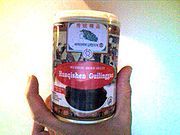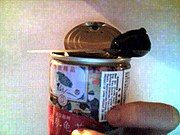Guilinggao
 | |
| Alternative names | Tortoise Jelly, Turtle Jelly |
|---|---|
| Type | Pudding |
| Course | Dessert |
| Place of origin | China |
| Main ingredients | Plastron, Chinese herbs |
| Guilinggao | |||||||||||
|---|---|---|---|---|---|---|---|---|---|---|---|
| Traditional Chinese | 龜苓膏 | ||||||||||
| Simplified Chinese | 龟苓膏 | ||||||||||
| Literal meaning | turtle and Smilax glabra jelly | ||||||||||
| |||||||||||
Guilinggao (Chinese: 龜苓膏; pinyin: Guīlínggāo), also known as tortoise jelly (though not technically correct) or turtle powder, is a jelly-like Chinese medicine, also sold as a dessert. It was traditionally made from the gao, or paste of the plastron (bottom shell) from the turtle Cuora trifasciata (commonly known as "three-lined box turtle", or "golden coin turtle", 金錢龜)[1] and a variety of herbal products, in particular, China roots Smilax glabra (土伏苓, Tu fu ling).[2][3] Although the critically endangered golden coin turtle (Cuora trifasciata) is commercially farmed in modern China, it is extremely expensive;[4] therefore, even when turtle-derived ingredients are used in commercially available guilinggao, they come from other, more commonly available, turtle species.[1][5]
More often, commercially available guilinggao sold as a dessert does not contain turtle shell powder. They share the same herbal additives as the medicine and are similarly marketed as being good for skin complexion when ingested.[6]
History
[edit]
According to a legend, the Tongzhi Emperor nearly cured his smallpox by taking guilinggao.[citation needed] However, Empress Dowager Cixi believed his disease could be cured by worshipping a smallpox idol. She succeeded in convincing the emperor to quit his guilinggao regimen. The emperor died soon after.[citation needed]
Guilinggao is thought to be good for the skin, allowing for a healthier complexion upon repeated consumption.[1] Other supposed positive effects of the jelly includes improving circulation, assisting muscle growth, relieving itching, reducing acne, and kidney restoration.[citation needed]
Variety
[edit]Regular guilinggao jelly is black in appearance; however, the actual color is more of a dark brown. Naturally, it is not sweet, but slightly bitter, although sweeteners such as honey can be added to make it more palatable.
Availability
[edit]Relatively inexpensive canned guilinggao jelly with poptop lids and plastic spoons for immediate consumption can be found in many East and Southeast Asian countries, as well as Chinatowns in the United States and Canada. It is also available for purchase in England and New Zealand. There are two varieties, one of them containing Lingzhi powder.
Preparation
[edit]Traditional guilinggao recipes require boiling turtle shell for many hours, first by itself, then with a variety of herbal ingredients, so that the liquid is gradually evaporated and a jelly-like residue forms. Rice flour and corn starch are added to thicken the product.[3][5]
Guilinggao jelly can be prepared at home from commercially sold powdered concentrate (the "guilinggao powder"),[3] similarly to how Jello is made. When it is prepared, other herbal substances, such as ginseng, are added to the jelly to give it certain tastes and medicinal values.
See also
[edit]
References
[edit]- ^ a b c Dharmananda, APPENDIX 1: "Golden Coin Turtle" (A report dated April 27, 2002 by ECES News (Earth Crash Earth Spirit)). Quote: "The popularity of turtle jelly can be seen in the success of Ng Yiu-ming. His chain of specialty stores has grown from one shop in 1991 to 68 today, in Hong Kong, Macau, and mainland China. Ng also packs turtle jelly into portable containers sold at convenience stores. He insists no golden coin turtles are used. 'They're too expensive' he said. '... [I]f you know how to choose the herbal ingredients, jelly made from other kinds of turtles will be just as good.'"
- ^ "Medicinal Turtle Preparation". chelonia.org. Retrieved August 30, 2018.
- ^ a b c Dharmananda, APPENDIX 3: "Tortoise Jelly (Turtle Jelly)"
- ^ Shi, Haitao; Parham, James F; Fan, Zhiyong; Hong, Meiling; Yin, Feng (2008-01-01), "Evidence for the massive scale of turtle farming in China", Oryx, vol. 42, Cambridge University Press, pp. 147–150, doi:10.1017/S0030605308000562 Also at http://sites.google.com/site/jfparham/2008Shi.pdf
- ^ a b Dharmananda, APPENDIX 2: "Softshell Turtle Farming". Quote: "Chinese softshell turtle used ... as a substitute ... for the golden coin turtle for making turtle jelly."
- ^ Lam, Nathalie (2013-10-09). "Turtle jelly not made from turtle?". Archived from the original on 2014-03-11. Retrieved 2017-08-30.
- Dharmananda, Subhuti. "Endangered species issues affecting turtles and tortoises used in Chinese medicine". See in particular:
APPENDIX 1: "Golden Coin Turtle" (A report dated April 27, 2002 by ECES News (Earth Crash Earth Spirit)),
APPENDIX 2: "Softshell Turtle Farming", and
APPENDIX 3: "Tortoise Jelly (Turtle Jelly)"


